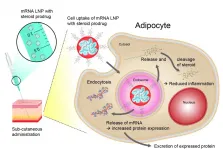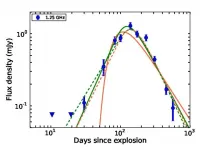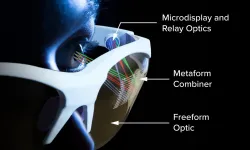Research with neutrons for better mRNA medicines
2021-05-03
(Press-News.org) If not before, then certainly since the first messenger RNA (mRNA) vaccines to combat the SARS CoV2 virus were approved in Germany, mRNA has become a recognized term even outside scientific circles. What is less well known is that mRNA can be used to produce much more than just vaccines. Around 50 different procedures for the treatment of diseases including cancer are already being studied in clinical trials. Scientists from the pharmaceutical company AstraZeneca, with the support of neutron researchers from Forschungszentrum Jülich, have now discovered how the subcutaneous administration of mRNA can be improved. The goal is for chronically ill patients to be able to self-administer the medication on a regular basis.
mRNA serves as a blueprint in our cells for the production of protein molecules. mRNA drugs could therefore create proteins directly in the patient's body, targeted at the site where they are needed. Besides cancer, many other diseases are potentially treatable: haemophilia, for example, where the formation of a clotting factor is disrupted, can be treated by administering the blueprint for this very factor. After heart attacks or strokes, injecting mRNA could enable the formation of proteins that allow new blood vessels to grow.
Compared to current therapeutics, producing mRNA is faster and more flexible, as mRNA can be easily manufactured and the process is independent of the mRNA sequence. In addition, the technology enables personalized drugs to be developed quickly and proteins can be produced in the body over an extended period of time and with modifications otherwise difficult to achieve.
mRNA is rapidly degraded in the body by ubiquitous enzymes. It is important to prevent this from happening before the mRNA reaches the cells where the protein synthesis takes place. In addition, it must be ensured that the messenger reaches the right cells and in sufficient quantities. Even though there are procedures in which the "naked" mRNA is administered, using secure packaging and some kind of "address label" is far more efficient.
An advanced packaging system is exemplified in so-called lipid nanoparticles (LNP), tiny vesicles made of a mixture of fat-like substances. Each of them fulfils a specific task, such as stabilising the construct or delivering it into the cell.
When administered intravenously or intramuscularly, the LNPs already fulfil their objectives sufficiently, but when administered subcutaneously, the LNP trigger significant inflammation. Subcutaneous application would be essential to enable patients to inject themselves with the drug, just as diabetes patients do with insulin. Particularly in chronic diseases that require regular doses of a drug, this would offer a great advantage.
So far, only small, insufficient quantities can be safely injected subcutaneously. Current studies from researchers at AstraZeneca and the Jülich Centre for Neutron Science (JCNS) show how this problem can be solved. The scientists supplemented the mRNA packaging with precursors of anti-inflammatory substances from the class of steroids. The body's own enzymes can convert these precursors into effective steroids at the site of injection.
Steroids have a strong anti-inflammatory effect, but can however have considerable side effects, especially if taken regularly. These side effects can be minimised by incorporating a steroid-precursor within the LNP so it is delivered and activated only at the site where it is needed i.e. the site where the LNPs are injected.
However, it is important to ensure that the steroid precursors are accessible to the enzymes. Therefore, they must be localised in the exterior of the lipid nanoparticles.
The researchers tried to ensure this by adding shorter or longer "fat-loving" extensions to the active substances. The idea is that the fat-loving areas would be inserted between the fatty substances of the LNP envelope in such a way that the steroid precursors would end up positioned on the outside. The scientists were able to prove that this is indeed the case with the help of neutron scattering studies at the small-angle scattering instrument KWS-2, operated by the JCNS at its outstation in the Heinz Maier-Leibnitz Zentrum in Garching.
"The KWS-2 instrument allows us to study fine structures, right down to nanostructures, using the contrast variation method," explains JCNS instrument scientist Dr. Aurel Radulescu. "In this process, the hydrogen atoms of individual components are exchanged for heavy hydrogen. This does not change the physical chemistry of the sample, but it does change the visibility for the neutrons. The neutrons can differentiate between the two isotopes and thus recognise which hydrogen atoms belong to which molecule." In this way, the different components of the lipid nanoparticles can be selectively labelled and differentiated from each other. And sure enough, the researchers found the steroid precursors on the outside of the particles, at least in the longer extensions.
"Understanding what the LNP surface looks like is fundamental to other challenges affecting LNP development," adds Dr. Marianna Yanez Arteta, Associate Principal Scientist in Advanced Drug Delivery at AstraZeneca. "Neutron scattering combined with selective isotope contrast is, to my knowledge, the only available technique that allows us to probe the lipid distribution and resolve the surface."
Further studies in AstraZeneca's laboratory confirmed the anti-inflammatory effect of the new LNP variants. The scientists also studied what length the fat-loving stem should be to ensure an optimal balance between efficient mRNA delivery and inflammatory response. "Incorporating an anti-inflammatory component into LNP greatly simplifies the therapy and may open it up to other treatments," predicts Dr. Yanez Arteta. If the anti-inflammatory LNPs now also prove their worth when used in humans, they could indeed unlock new therapeutic options for a wide range of diseases.
INFORMATION:
[Attachments] See images for this press release:

ELSE PRESS RELEASES FROM THIS DATE:
2021-05-03
Scientists from the National Centre for radio Astrophysics of the Tata Institute of Fundamental Research (NCRA-TIFR) Pune used the upgraded Giant Metrewave Radio Telescope (uGMRT) to determine that AT 2018 cow, the first of a newly discovered class of cosmic explosions, has an extremely patchy environment. Sources like AT 2018cow release an enormous amount of energy, nonetheless fade extremely rapidly. This along with their extremely blue color has led to them being called FBOTs for Fast Blue Optical Transient. This is the first observational evidence of inhomogeneous emission from an FBOT. The origins of FBOTs are still under debate, but proposed models include explosion of a massive star, collision of an accreting neutron star and ...
2021-05-03
"Image" is everything in the $20 billion market for AR/VR glasses. Consumers are looking for glasses that are compact and easy to wear, delivering high-quality imagery with socially acceptable optics that don't look like "bug eyes."
University of Rochester researchers at the Institute of Optics have come up with a novel technology to deliver those attributes with maximum effect. In a paper in Science Advances, they describe imprinting freeform optics with a nanophotonic optical element called "a metasurface."
The metasurface is a veritable forest of tiny, silver, nanoscale structures on a thin metallic film that conforms, in this advance, to the freeform shape of ...
2021-05-03
According to Michael Twidale, professor in the School of Information Sciences at the University of Illinois Urbana-Champaign, bad usability can be an irritation for everyone but "especially awful" for the underprivileged. In "Everyone Everywhere: A Distributed and Embedded Paradigm for Usability," which was recently published in the Journal of the Association for Information Science and Technology (JASIST), Twidale and coauthors David M. Nichols (University of Waikato, New Zealand) and Christopher P. Lueg (Bern University of Applied Sciences, Switzerland) present a new paradigm to address the persistence of difficulties that people have ...
2021-05-03
(New York, NY) - May 3, 2021 - In advance of a wildfire season projected to be among the worst, the American Thoracic Society has released a report that calls for a unified federal response to wildfires that includes investment in research on smoke exposure and forecasting, health impacts of smoke, evaluation of interventions, and a clear and coordinated communication strategy to protect public health.
The report, Respiratory Impacts of Wildland Fire Smoke: Future Challenges and Policy Opportunities, was published online ahead of print in the Annals of the American Thoracic Society on May 3, 2021.
The report comes at a time when the U.S. is experiencing an increasing frequency of very large destructive wildfires, due to years ...
2021-05-03
Over 400 common disinfectants currently in use could be made safer for people and the environment and could better fight the COVID-19 virus with the simple application of UVC light, a new study from the University of Waterloo shows.
Benzalkonium chloride (BAK) is the most common active ingredient in many disinfectants regularly used in hospitals, households, and food processing plants to protect against a wide range of viruses and bacteria - including all strains of SARS-CoV-2, the coronavirus that causes COVID-19 - but its toxicity means that it can't be used in high concentrations. It also means that products containing BAK are harmful to humans ...
2021-05-03
LUGANO, Switzerland, 3 May 2021 - As breast cancer becomes a largely curable disease, with more than 70% of women surviving at least 10 years after diagnosis across most of Europe thanks to early detection and treatment, (1) the quality of life after cancer has become an important aspect of the patient journey - one that may be inadequately addressed with current standards of follow-up. A study presented at the ESMO Breast Cancer 2021 Virtual Congress (2) has shown that breast cancer survivors differ widely in the burden of symptoms they experience after the end of treatment and thereby revealed an unmet need for tailored approaches to follow-up care. (3)
Lead author Kelly de Ligt ...
2021-05-03
TORONTO - Scientists at the Krembil Brain Institute, part of University Health Network (UHN), in collaboration with colleagues at the Centre for Addiction and Mental Health (CAMH), have used precious and rare access to live human cortical tissue to identify functionally important features that make human neurons unique.
This experimental work is among the first of its kind on live human neurons and one of the largest studies of the diversity of human cortical pyramidal cells to date.
"The goal of this study was to understand what makes human brain cells 'human,' and how human neuron circuitry functions as it does," says Dr. Taufik Valiante, neurosurgeon, scientist at the Krembil Brain Institute at UHN and co-senior author on the paper.
"In our study, we wanted ...
2021-05-03
Customised medicines could one day be manufactured to patients' individual needs, with University of East Anglia (UEA) researchers investigating technology to 3D 'print' pills.
The team, including Dr Andy Gleadall and Prof Richard Bibb at Loughborough University, identified a new additive manufacturing method to allow the 3D printing of medicine in highly porous structures, which can be used to regulate the rate of drug release from the medicine to the body when taken orally.
Dr Sheng Qi, a Reader in Pharmaceutics at UEA's School of Pharmacy, led the research. The project findings, 'Effects of porosity on drug release kinetics of swellable and erodible porous pharmaceutical solid dosage forms ...
2021-05-03
A research team from the Institut de Neurociències at the Universitat Autònoma de Barcelona (INc-UAB) has showed that inhibition through a drug of the Tac2 neuronal circuit, involved in the formation of the memory of fear, has opposite effects on the ability to remember aversive events in mice according to sex: it is reduced in male mice and increased in female mice.
Is the first time that a drug has been shown to produce this opposite effect on the memory of male and female mice. The study also evidences that opposing molecular mechanisms and behaviours can occur ...
2021-05-03
Diatoms are tiny unicellular plants -- no bigger than half a millimeter -- which inhabit the surface water of the world's oceans where sunlight penetration is plenty. Despite their modest size, they are one of the world's most powerful resources for removing carbon dioxide (CO2) from the atmosphere. They currently remove, or "fix," 10-20 billion metric tons of CO2 every year by the process of photosynthesis. But not much is known about which biological mechanisms diatoms use, and whether these processes might become less effective with rising ocean acidity, temperatures, and, in particular, CO2 concentrations. A new study in Frontiers in Plant Science shows that diatoms predominantly ...
LAST 30 PRESS RELEASES:
[Press-News.org] Research with neutrons for better mRNA medicines





